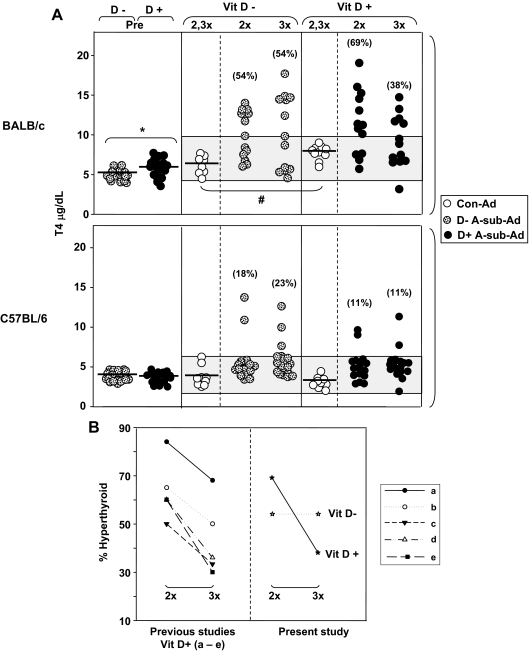Figure 6.
A, Vitamin D deficiency reduces preimmunization serum T4 and maintains hyperthyroidism in BALB/c (not C57BL/6 mice) immunized with A-sub-Ad. T4 levels (micrograms per deciliter) are shown for individual animals. Preimmunization (Pre) sera were obtained by tail bleeding after 6 wk on vitamin D-deficient (D−) or -sufficient (D+) diet (n = 18 per group). Subsequently, mice were maintained on their respective diets and immunized with A-sub-Ad (BALB/c, n = 13; C57BL/6, n = 17) or Con-Ad (n = 4–5 mice). Sera were tested 1 wk after two injections of A-sub-Ad (2x), and mice were euthanized a month after the third immunization (3x). The shaded areas represent the mean ± 2 sd values (in each strain) for D− and D+ mice after two and three (2,3x) immunizations with Con-Ad. The percentage of hyperthyroid animals for each group is in parentheses. Values significantly different are indicated as follows: preimmunization BALB/c D− vs. D+: *, P = 0.024 (t test); Con-Ad immunization BALB/c D− vs. D+: #, P = 0.006 (t test). B, Percentages of BALB/c mice that are hyperthyroid after two (2x) and three (3x) A-sub-Ad immunizations. Observations in the present study for vitamin D-sufficient (D+) and -deficient (D−) BALB/c mice are compared with data from five other studies (a–e, Refs. 24,25,26, 29, and Misharin A., B. Rapoport, and S. M. McLachlan, unpublished). Significantly fewer mice remained hyperthyroid after three immunizations (χ2 P = 0.029 for these five other studies of BALB/c mice on regular mouse chow; P = 0.013 combining previous data with those for D + mice).

